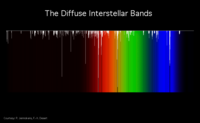
Photo from wikipedia
Abstract The nature of the solvent and composition of the solution in which optical absorption spectra are acquired can substantially affect the structures of analytes as well as spectra and… Click to show full abstract
Abstract The nature of the solvent and composition of the solution in which optical absorption spectra are acquired can substantially affect the structures of analytes as well as spectra and relative intensities of spectral features. We have computed the effects of the solvent for dilute solutions on the electronic absorption spectra and structures of a prototypical porphyrin—free-base porphyrin (herein referred to as FBP and H2FBP)—and its protonated form (H4FBP) in the ground and the lowest triplet states, both important in device and medical applications. Density functional theory (DFT) and time-dependent-DFT (TD-DFT) have been employed to investigate solvent effects on structure and singlet-singlet (S0 → Sn) and triplet-triplet (T1 → Tn) absorption spectra. We also calculated the solvent dependence of energy gaps between optically allowed singlet and nearest triplet states for the species. Soret band positions are found to be strongly solvent dependent, but less so are Q bands. The finding of dependence of the spectroscopic features of the porphyrin on the dielectric constant of the solvent, from 1.00 (gas-phase) to about 20.493 (acetone)—with the features becoming stable for polar solvents with the dielectric constants e > 20—can be used to monitor micro environmental changes of porphyrin (and its derivatives) embedded in biological systems and nanoparticles; such composites may also be suitable to study and monitor modifications of the chemical environment in different solutions and interactions with biological systems and nanoparticles. This is first systematical study on the solvent-dependence of the porphyrin compounds.
Journal Title: Computational and Theoretical Chemistry
Year Published: 2018
Link to full text (if available)
Share on Social Media: Sign Up to like & get
recommendations!